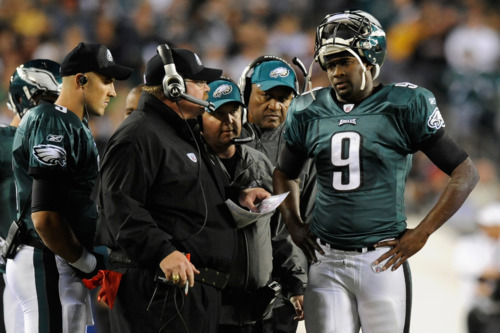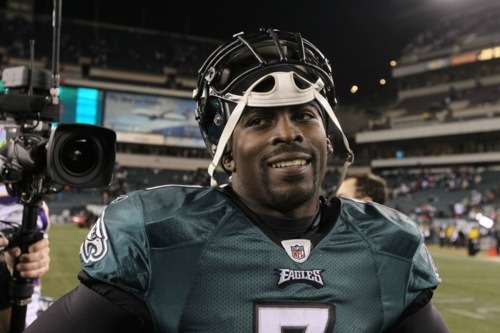When Chip Kelly entered the NFL in 2013, many people derided his offense as a "college" or "gimmick" system, with its unconventional no huddle, quarterback read option, plus other aspects of the spread. Kelly pioneered packaged play concepts (those run-pass hybrids) and play call communication techniques like giant signs and coaches doing weird hand signals. Anyone who thought that wouldn't work was wrong. His offense rocked the league in year one, putting up big numbers and carrying a terrible defense to the playoffs.
Many Eagles fans, including myself, enjoyed a victory lap. We taunted the idiotic commentators who questioned Chip's revolution and basked in the glory of his high octane offense. He looked like perhaps the best coach in the NFL, someone we could count on for a tactical advantage for years to come.
But the dirty truth is that winning in the NFL is a result of many, many things, and scheme isn't that high on the list. Actually, scheme may be the least important—because it's the one anybody can copy or subvert. The offensive elements that Chip brought to the league are already being adopted widely. Bill Belichick and Tom Brady borrowed one-word play calls and no huddle from Chip years ago, and both concepts are now widely practiced by teams as old school as the New York Giants. The read option is overtaking the classic I-formation as the trusted standby for numerous teams with mobile quarterbacks. Packaged plays are everywhere. Even his prized sports science may soon be table stakes.
Meanwhile, Kelly has had to make compromises on his core tenets. As it turns out, quarterbacks are not fungible at the NFL level. You can't go from Dennis Dixon to Jeremiah Masoli to Darron Thomas, winning all the way. Chip has struggled to fit indecisive, immobile QBs like Nick Foles and Mark Sanchez and Sam Bradford into his offense, its purest form diluted by the slow feet and damning inconsistencies of each signal caller.
And NFL defensive coordinators are getting paid too. Gone is Chip's surprise factor. These days, the Eagles offense is more likely to be surprised by the defense than the other way around. (Oddly, Chip's offense seems to have shrunk rather than grown over the years.) Recently, for example, defensive line stunts designed by smart defensive coaches like Rob Marinelli and Dan Quinn have crippled Kelly's vaunted interior run game.
Overall, the scheme playing field is being leveled. And as that advantage fades, other factors become much more important—talent being number one. Acquiring, developing, and retaining talent is 90% of what makes a good football team in the long term. Yes, the less-talented team can luck into a win for any one game. And luck and scheme and hard work can overcome the odds over the course of a season. But if you want to win consistently in a competitive league, you need more.
Just because you're a brilliant engineer doesn't make you a good salesman. Just because you can write doesn't mean you can add. Just because you're a star performer doesn't mean you can manage others. Yet in football, teams have a habit of assuming that their coach can do much more than coach.
Kelly is a smart coach, with a novel and mostly effective scheme. But he is a woeful manager of personnel. I wrote the offseason about the cascade effect of his poor decisions, and the list was long then. But it's getting longer. Sam Bradford looks like a timid check down artist. Byron Maxwell is doing a great Bradley Fletcher impression for $22 million guaranteed. The Evan Mathis cut was questionable from the start, but is appalling now with the current state of the offensive line—a unit whose problems have canceled out any positive effect of a shiny new stable of (expensive) running backs.
In college, Chip didn't have the constraints of the salary cap or the draft or free agency. He was never the best recruiter, but he did fine; from 2010-2012, his recruiting classes ranked top 15 in the country. (At most, Oregon played 3 games a season against opponents who recruited at that level, and went about .500 in those match-ups.) Every year he added another 20-25 new players to a scholarship roster of 85, a game day pool 60% larger than the NFL. If a recruit didn't work out, there was always someone else to take his place, and none of them ever got too old and slow or cost too much money.
Under those conditions, the scheme was just icing on the cake. Kelly maximized the talent advantage he already enjoyed, and thus he won most of the time. But in the NFL, talent margins are too thin to ever make scheme a permanent advantage. Defenders who weren't smart enough or fast enough to disrupt the Oregon offense never made it to the NFL, and the best players are rationed out to professional teams, keeping the league in a constant tumble of parity. Plus, coaches are, for the most part, smarter. They won't sit back and let you call the same three run plays over and over. Oh, and you actually need starting-caliber guards to execute any scheme.
Hopefully Kelly can make some rapid adjustments this week. He needs to add new wrinkles to his play calling and consider benching one or more of his under-performing linemen. He needs to prove that Bradford was worth the major investment the Eagles made for him. The team is only 0-2, and the rest of the NFC East is putrid. There's plenty of time to come back—if he starts right now.
Still, I worry that the NFL has caught up to Chip, and Chip hasn't caught up to the NFL. Opponents are all over his early scheme innovations. But Kelly never figured out the intricacies of running all the aspects of a professional football team, the job he aspired to and finally wrested from Howie Roseman this offseason. The NFL is a lot harder than it looks on Sunday, and maybe we're finally seeing that.



